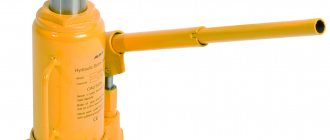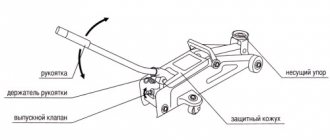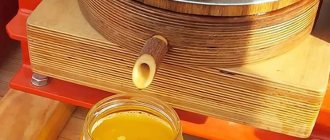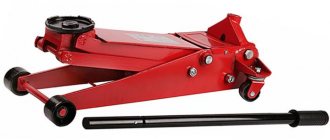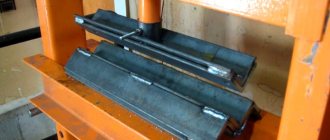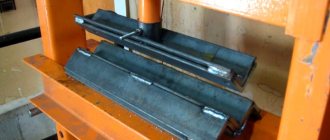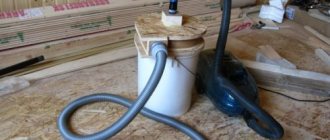Like any device that operates on hydraulics, the jack must be periodically checked and, if necessary, added oil and pumped the system. If air bubbles appear in the hydraulic jack, it loses its functionality, so it is necessary to carry out bleeding in a timely manner. Experts recommend pumping equipment at least 2 times annually. This frequency will prevent premature wear of the jack and allow it to last for decades. Since bleeding a hydraulic jack is quite easy, any motorist can perform this procedure.
Application of hydraulic jacks
hydraulic jack
Lifting devices are used for fixing, moving and lifting heavy loads: building slabs, machine tools, cars, columns. Their carrying capacity can be hundreds of tons. Depending on the purpose, the design and dimensions of the machine vary. High performance and ease of maintenance have made jacks indispensable in manufacturing, car service stations, the processing industry, power plants, warehouses and other production areas. Car enthusiasts also cannot do without their own compact lifts. And the ability to move loads vertically and horizontally is used everywhere on construction sites.
Some final tips
The performance of the jack depends on the quality of the lubricants that are poured into it. You should not skimp on oil, as this can lead to serious damage that will not be repairable in the future. If the device will be used in various conditions with temperature changes, it is better to fill the jack with a frost-resistant synthetic lubricant, which will preserve the functionality of the system.
In winter, it is better to refrain from using the device for a long time in the cold, since all gaskets and seals are very sensitive to low temperatures.
A hydraulic jack is a mechanism that allows you to lift an object to a certain height. Most often used in technical maintenance services.
Bleeding a hydraulic jack is required in the following cases: contamination and air ingress into the working area of the jack, the formation of corrosion in the mechanism and its damage, deformation of the hydraulic rod due to heavy loads. And also depending on the type of jack and frequency of use.
Hydraulic lift device
jack elements
The main components of the system are the housing, the movable piston and the liquid medium (machine oil). The body is made of durable metal in the shape of a cylinder. It serves as both a guide for the rod and a container for technical fluid. Additional elements that bring the device into operation:
- lever arm;
- valves;
- plunger.
The use of valves makes it possible to increase the force applied to the lever tens of times. The plunger is necessary to move the piston by transporting the working fluid into the container below it. The valve prevents liquid from flowing back into the common container. Gradually, the plunger pumps more and more liquid under the piston, raising it. And in order for the load to drop, you only need to allow the oil to return to the common container by slightly opening the valve.
Basic misuse errors that lead to breakdowns and how to avoid them
A hydraulic jack is a useful thing, but, unfortunately, it does not last forever. If the lift is not functioning properly, you have to wonder what caused it to fail and why the hydraulic jack is not lifting 5 tons under load. The most common reason for this phenomenon is oil leakage. To avoid such a problem, it is necessary to constantly add and monitor the volume of liquid in the cylinder. A decrease in the volume of working fluid is caused by a damaged seal, oil seals, as well as its natural loss.
Hydraulic jack oil seals
Another common cause of hydraulic equipment failure is corrosion. If it appears on the inside of the housing or on the retractable piston, breakdowns will be frequent and serious. A bent stem is also a serious problem. This can be explained by the fact that, with certain design features of the equipment, parts that have become unusable can be replaced. But often a hydraulic or bottle jack with a faulty rod is problematic to repair even in a special workshop.
Regardless of what led to the breakdown of the lifting structure, it is better for an inexperienced motorist to entrust its bleeding and repair to a specialist. After all, even though the services of a professional will cost a little more than repairing it yourself, in a specialized center you can get a guarantee that the repaired structure will function optimally and efficiently. This will also help avoid even greater damage that will no longer be possible to fix.
Pros and cons of hydraulic jacks
Advantages:
- high power;
- ease of operation and maintenance;
- high level of efficiency - about 80%;
- ability to move cargo weighing up to 200 tons.
Flaws:
- are not able to lift loads from low heights;
- the level of lowering the load cannot be determined;
- requires constant monitoring and maintenance: adding oil, replacing gaskets and seals;
- they can only be transported and stored in a vertical position, otherwise the working fluid will leak out;
- they work quite slowly, cyclically, lifting the load to a small height each time;
- quite expensive;
- they break down more often and repairs are more expensive than their mechanical counterparts.
Refueling mechanisms
Next, we’ll look at how to properly fill the recommended oil into a jack. Sometimes, if transported incorrectly, hydraulic fluid can spill out and the voids can be filled with air. This will cause the jack to fail. In this case, an oil change is necessary.
The rack and pinion mechanism is quite large; it is used not only for lifting the body, but also for repairing old buildings. Before changing the lubricant, the mechanism must be completely lowered. To verify this, you can relieve residual stress by turning the exhaust valve counterclockwise.
The neck into which the filling is made is usually located on the tank body, usually in the lower part of the cylinder. It is necessary to free the neck from the bolt or plug that reliably protects the oil in the container. Then you will need an oil can, the nozzle of which must be inserted into the neck and filled.
Types of hydraulic jacks
Several types of devices have been created that are convenient for use in various fields:
- bottled;
- hybrid;
- rolling;
- diamond;
- hooked.
The bottle jack is the most common and simplest design. It is capable of lifting from two to hundreds of tons, has a large support area and a compact body. Therefore, such mechanisms are usually used when repairing various types of vehicles, especially trucks. Bottle jacks can have a double-rod or single-rod design. Single-rod, simpler devices, are used in the maintenance of railway cars, in construction, mechanical engineering, and in the production of pipe cutters and pipe benders. Double rod models work vertically and horizontally.
The design of a rolling jack resembles a trolley, which during operation moves under the lifted load. Operated by a hand lever and regulated by an oil valve. To open the valve, you must turn the valve screw handle. Very convenient for one-sided lifting of loads. Therefore, it is good when changing a wheel. But it works exclusively on hard and flat surfaces. There is a transmission type that has a rotating frame in its design.
Hybrid jacks are also called two-level jacks and are used in car repair shops. Their convenience is the presence of a couple of platforms for cargo. In fact, it is a combination of bottle and roll-on models. The machine is controlled by a foot pedal and lever.
The diamond jack is also used in car repair shops. The bearings, connected by hinges, form a rhombus. Hence the name of the mechanism. A very compact device, easy to transport and store.
A hook jack is good where it is necessary to lift a load from a small height: moving machine tools, railway rails. The design is based on a bottle design.
Recommendations for use
After finishing use, the jack must be freed from loads. The device should be stored in a warm and dry place. Due to excess moisture, the mechanism may rust, and cold will negatively affect the quality of the oil. It is recommended not to work with a jack in severe frost.
Loads on the device should not exceed those for which it is designed.
With constant use, pumping (oil change) should be carried out every 2-3 months. For rare use - once every six months.
Thus, in the event of a hydraulic jack failure, it is necessary to check 3 components:
- Quality and quantity of liquid.
- Presence of air bubbles in the system.
- Contamination, loose valve fit.
In most situations, to solve all problems with the device, it is enough to clean it and change the oil.
Good day everyone!
During the previous replacement of the pads, my favorite, dearly cherished jack broke, which had been chosen for a long time to replace the diamond in the previous car and reinforced after the gears were shifted in the upper part. The old one was also strengthened in the lower part.
It is reinforced with the same half-inch barrels, at the ends of which a centimeter groove was cut for easier installation inside the jack foot. The studs were removed and their place was taken by powerful Soviet bolts with washers and grommets (not to be confused with Chinese crap from hardware stores)). Now there is nothing to break in the jack, the metal is thick and durable, it will help you out on the road.
Since diamond jacks are still tools for emergency use only, a 3-ton rolling jack was purchased.
Read also: How to adjust the drainage pump float
I decided to take a chance and took a rolling jack “Service Key” for restoration, catalog number 75040, load capacity 3t, lifting height 150-530mm
, although at the same time there was an opportunity to purchase a new 2-ton “Avtovirazh” AV-076002 for 1300 in Chumadan.
But 3 tons is still 3 tons! In addition, a large and massive jack is more suitable for working with Qashqai. The jack was received in a non-working condition, according to the former owner, “it doesn’t rise all the way and who the hell knows what’s wrong with it...”. So what did I do? The first thing I did was disassemble it completely and wash it.
There was no oil in the jack. Filled it up. Choked from the plunger. The rod began to twitch and... nothing. The first experience was unsuccessful.
I monitored the Internet. I read and looked at everything about jacks, rolling jacks and others))). On the drive I found information about a similar jack from SarEcks
.
I contacted him, then three more owners of 2 tons and samodelkin689
,
Godmask82
and
COSWORTH23
. Thank them very much for their response and participation. But the design of those jacks was similar, but the plunger pump was still different from mine. It was decided to buy new seals. Shopping trips for passenger cars yielded nothing. The store bought rubber rings for Belaz-Kamaz trucks with a reserve.
Balls from bearings of various diameters were found, and a BiC automatic ballpoint pen was disassembled in order to obtain a spring. Next, I will write strictly to the point, for those who are faced with repairing a jack. I've seen enough lyrics on the Internet and haven't found any specifics that apply to my jack. There are 4 balls in the jack
.
These are valves. Moreover, one of them is located in the plunger channel leading to the main (working) cylinder (check valve). IT DOESN'T COME OUT
! The second ball with a diameter of 3 (or 4) mm is located in the bypass valve. The third ball with a diameter of 6.5 mm is in the bypass valve. The fourth, with a diameter of 6 mm, is located at the base of the main cylinder, in a recess and must be pressed with a spring (like from a ballpoint pen) 8 mm long. The other end of the spring rests against a large washer, which simultaneously serves as a seal for the main (working) cylinder. Often no one knows about this necessary spring, but if it is missing, the jack may not work!
When inserting the piston, the twisted working cylinder should not leak at the point of contact with this washer. In my jack, half of the shut-off valves were missing and the plunger pump was leaking. 2 new rings were installed on the plunger: one in its regular place, the second, I moved the plastic ring into the formed groove. Those. The result was three seals for the plunger rod: the piston itself and two rings. A paronite washer is installed under the screw-in pump housing for sealing instead of the old steel one.
Now the pump does not flow. In the large piston, the O-ring is replaced with a ring of the same diameter, but thicker.
That's all the work done. The jack works great.
The car can easily be lifted half a meter on 2 wheels.
I hope this description helps someone. If you have any questions, I will be happy to answer. Peace and goodness to everyone.
When lifting heavy objects to a small height, a special technical device of a hydraulic, pneumatic or mechanical type is used. The operation will be performed by a small but strong device known as a jack. It is possible to repair a rolling hydraulic jack yourself.
Do-it-yourself repair and bleeding of the jack
diamond jack
There are several factors that lead to malfunction of the hydraulic lift:
- lack of oil;
- air penetration;
- accumulation of dirt and rust;
- rod deformation.
During use of the device, oil gradually leaks out, so it should be added from time to time. This is done using a repair kit. Before starting work, you should prepare a bucket for draining used and fresh technical oil.
Progress:
- use wrenches to remove the fastening;
- you get the drain valve and piston;
- pistons are cleaned of dirt, rust and checked for chips and deformation;
- The bleed valve is thoroughly cleaned inside and out. If chips or bends are found on the valve, it is useless to put it back; it must be replaced. When inspecting the valve, it is important not to lose the metal ball. Its loose fit to the saddle disrupts the operation of the jack;
- Now the used oil is drained by pumping: the lever must be moved up and down until the oil passes into the main cylinder. Bleeding the jack is usually not difficult, although it does require patience;
- after draining the oil, all other parts are cleaned;
- Gaskets and cuffs are replaced, since their defects are often impossible to notice, but under pressure they make themselves felt.
The best way to clean the jack from dirt is to wash it with kerosene. After bleeding the oil, kerosene is poured into the working container and the jack is pumped. The locking needle is first removed. After which the kerosene is released and the device is filled with new working fluid.
Air penetration
Air in hydraulics always leads to disastrous consequences. This is because air pockets can change their volume when compressed. Many manufacturers create a sealed design, with the exception of a few valves.
Air enters the cylinder due to mechanical damage or improper operation of the valves. Problems also arise if the oil is not filled correctly.
Bleeding the jack
Rules of care
If a 2-ton rolling jack does not lift, repairs can be carried out at home. But to prevent this from happening, timely prevention must be carried out. Of course, no one says that the device will last indefinitely, but you can extend its service life several times.
Provide good storage conditions for the jack. Monitor the quantity and quality of the working fluid. Clean the device from dirt in a timely manner. Do not forget that it is not recommended to overload the device.
